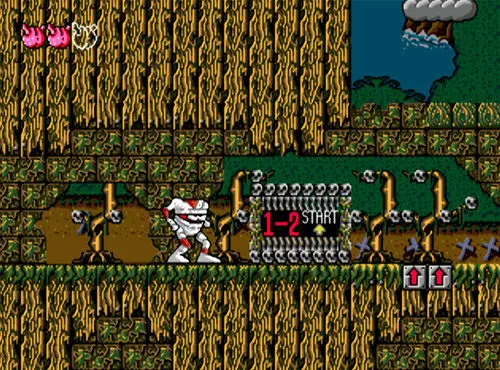Decap Attack
- Genre: Platformer
- Players: 1
- Developer: Vic Tokai
- Publisher: Sega
Description
Released for the Sega Genesis/Mega Drive in 1991, Decap Attack (known as Magical Hat no Buttobi Turbo! Daibōken in Japan) stands as one of gaming's most delightfully weird creations. Developed by Vic Tokai, this platformer combined horror elements with cartoonish humor to create an experience that was as strange as it was addictive.
A Head-Throwing Hero
The protagonist of Decap Attack, Chuck D. Head, was no ordinary video game hero:
- A mummy-like creation with no head (instead having a face embedded in his torso)
- Could extend his skull-like head on a stretchy spine to attack enemies
- Could throw his detachable head as a projectile weapon
- Would reveal a second face on his chest when his head was deployed
This bizarre character design was complemented by equally strange animations, with Chuck's body stretching, contorting, and bouncing in exaggerated ways that gave the game a unique visual identity.
The Island of Max D. Cap
The game's setting was the monster-infested Isle of Illusion, recently broken into seven separate islands by the evil Max D. Cap (a wordplay on "decapitation"). As Chuck, players ventured through these islands to defeat Max and his henchman, Dr. Frank N. Stein.
Each island featured distinct themes:
- Forests filled with sentient trees and mushrooms
- Icy mountains with slippery surfaces and snowmen
- Volcanic regions with lava pits and fire creatures
- Haunted castles with ghostly apparitions
- Underground caverns with mining hazards
- Cloudy skies with precarious platforms
- The final island housing Max D. Cap's fortress
Gameplay: Head and Shoulders Above
Decap Attack's gameplay loop was built around Chuck's unique abilities:
- Standard attacks involved extending his head to hit enemies
- Throwing his head allowed for distance attacks but left Chuck vulnerable
- Power-ups included potions to increase throw distance and bombs for screen-clearing attacks
- Hidden throughout levels were coins, extra lives, and special items
The control scheme was remarkably responsive, allowing for precise platforming despite the character's ungainly appearance. Chuck's momentum-based movement added challenge to the platforming sections, requiring players to master his unique physics.
The Helper: Igor
Adding to the game's quirky charm was Igor, Chuck's diminutive assistant:
- Could be found hiding in specific pots throughout the levels
- Provided Chuck with special items and power-ups
- Offered hints about secret areas and boss weaknesses
- Had his own humorous animations and expressions
Igor's inclusion added a treasure-hunting element to the gameplay, encouraging thorough exploration of each level.
The Macabre Meets the Comical
What made Decap Attack stand out was its unique aesthetic—a blend of horror tropes and slapstick humor:
- Enemies included standard horror fare like bats, skeletons, and ghosts
- Chuck's deaths were comically exaggerated, with his body parts flying in different directions
- Sound effects were cartoonish, with bonks, boings, and splatters
- The music ranged from spooky to oddly upbeat
This combination created a game that was accessible to younger players while still appealing to those who appreciated its darker undertones.
Challenging Difficulty Curve
Behind the silly facade lay a legitimately challenging platformer:
- Later levels featured precise jumping sequences over instant-death hazards
- Bosses required specific strategies and pattern recognition
- Limited lives and continues meant game overs were a real threat
- Secret areas contained essential items for completing later challenges
This difficulty ensured that despite its comical appearance, Decap Attack provided substantial gameplay depth for dedicated players.
The Map System
Between levels, players navigated an overworld map that showed their progress through each island:
- Completed levels were marked with Chuck's smiling face
- Secret exits and hidden paths could be discovered
- Returning to previous levels was sometimes necessary to find missed items
- Bonus stages could be accessed from specific map points
This system gave players a sense of progression and allowed the game to include branching paths and optional challenges.
The Legacy of a Headless Wonder
While Decap Attack never achieved the fame of Sonic or Mario, it developed a dedicated cult following for several reasons:
- Its utterly unique premise and character design
- Solid platforming mechanics that rewarded skill
- The perfect balance of challenge and accessibility
- Its distinctively weird sense of humor
The game remains a testament to the creative freedom developers enjoyed during the 16-bit era, when outlandish concepts could become fully realized games that pushed the boundaries of conventional design.
For those lucky enough to have experienced Chuck's adventures in their youth, Decap Attack represents the wonderful weirdness that made the Genesis/Mega Drive library so diverse and memorable. It stands as a reminder that sometimes the strangest ideas make for the most unforgettable gaming experiences.
"Don't lose your head over this game... Chuck already did!"
This post contains affiliate links. If you click through and make a purchase, I may receive a small commission at no extra cost to you.
